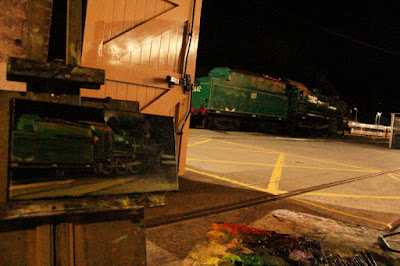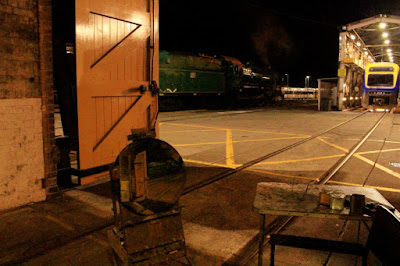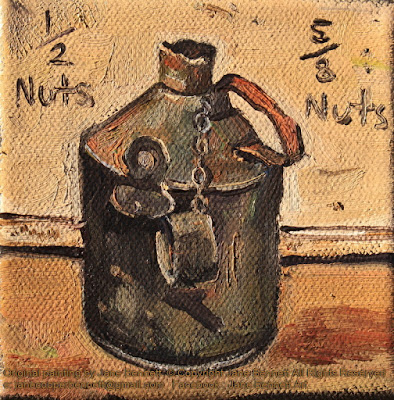 |
| 3642 steaming at night from the Large 2017 oil on canvas tondo 31 x 31cm Large Erecting Shop, Eveleigh Railway Workshops' 2017 oil on canvas 15 x 31cm 'Carriage and windows, night, Large Erecting Shop' 2017 oil on canvas 25 x 20cm Available |
On Thursday 20th July the heritage steam locomotive 3642 made a brief nocturnal visit to the Large Erecting Shop, Eveleigh Railway Workshops.
Despite the biting cold and sharp gusts of wind, I managed to paint 2 small oil studies of 3642 steaming outside the shed at night, as well as an interior of the Large Erecting Shop, before my fingers finally became too numb to hold a brush.
Despite the biting cold and sharp gusts of wind, I managed to paint 2 small oil studies of 3642 steaming outside the shed at night, as well as an interior of the Large Erecting Shop, before my fingers finally became too numb to hold a brush.
 |
| '3642 steaming at night from the Large Erecting Shop, Eveleigh Railway Workshops' 2017 oil on canvas 15 x 31cm Available |
3642 was making this brief pit-stop at Eveleigh, before a historic
journey to celebrate 150 years since the first regular passenger train
travelled from Penrith to Weatherboard (known today as Wentworth Falls).
 |
 |
| '3642 steaming at night from the Large' 2017 oil on canvas 31 x 31cm |
3642 was built for
the New South Wales Government Railways in 1926 by Clyde Engineering and hauled passenger trains throughout NSW.
Originally painted black, it was painted green in the mid-1930s, but repainted black at the start of World War II.
It was withdrawn from operational service in September 1969, and moved to the NSW Rail Transport Museum until cracking was discovered in its firebox in 1973.
3642 was sent to Goulburn Roundhouse in 1979 to be overhauled and returned to service in November 1981.
In December 1994, 3642 was again withdrawn from service when the rear driving axle failed an ultrasonic test, and became a static exhibit at Thirlmere until restoration work began in 2006.
It returned to service in March 2008 and by the end of the year, the engine was yet again repainted green.
In July 2011, it was taken out of service for an overhaul before returning to service in April 2012.
In December 1994, 3642 was again withdrawn from service when the rear driving axle failed an ultrasonic test, and became a static exhibit at Thirlmere until restoration work began in 2006.
It returned to service in March 2008 and by the end of the year, the engine was yet again repainted green.
In July 2011, it was taken out of service for an overhaul before returning to service in April 2012.
 |
'3642 steaming at night from the Large'
My first small oil study was a straightforward rendering of the locomotive, but I had also brought a small tondo (circular canvas) to experiment with a different sort of composition. I used the huge and very sturdy doors of the shed to frame the steaming locomotive, and the tracks snake their way directly towards the viewer. The night lights turned the steam into puffs of iridescent blue, mauve and rose. More paintings of Eveleigh Railway Workshops at my Eveleigh page in this blog |


















